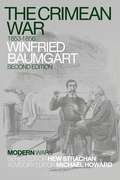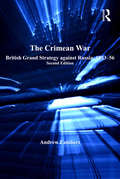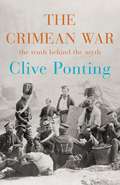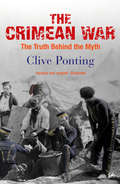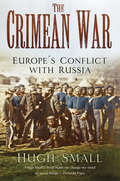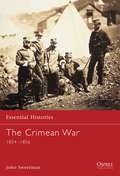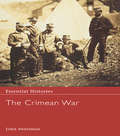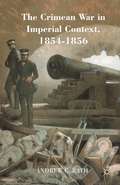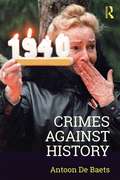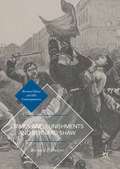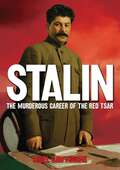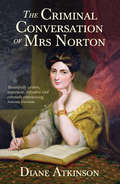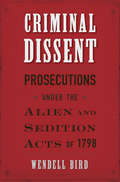- Table View
- List View
The Crimean Tatars: From Soviet Genocide to Putin's Conquest
by Brian Glyn WilliamsThe Russian annexation of the Crimea in March 2014 focused the world's attention on the Peninsula in ways not seen since the Crimean War. Thousands of Crimean Tatars clashed with pro-Russian militiamen in Simferopol, while Moscow has in turn stoked fears of jihadi terrorism among the overwhelmingly Muslim Tatars as retrospective justification for its invasion. The key thread in this book is the Crimean Tatars' changing relationship with their Vatan (homeland) and how this interaction with their natal territory changed under the Ottoman Sultans, Russian Tsars, Soviet Commissars, post-Soviet Ukrainian authorities and now Putin's Russia. Taking as its starting point the 1783 Russian conquest of the independent Tatar state known as the Crimean Khanate, Williams explains how the peninsula's native population, with ethnic roots among the Goths, Kipchak Turks, and Mongols, was scattered across the Ottoman Empire. He also traces their later emigration and the radical transformation of this conservative tribal-religious group into a modern, politically mobilized, secular nation under Soviet rule. Stalin's genocidal deportation of the Crimean Tatars in 1944 to Uzbekistan and their almost messianic return to their cherished 'Green Isle' in the 1990s are examined in detail, while the author's archival investigations are bolstered by his field research among the Crimean Tatar exiles in Uzbekistan and in their samozakhvat (self-seized) squatter camps and settlements in the Crimea.
The Crimean War: 1853-1856 (Modern Wars)
by Winfried BaumgartWinfried Baumgart's masterful history of the Crimean War has been expanded and fully updated to reflect advances made in the field since the book's first publication. It convincingly argues that if the war had continued after 1856, the First World War would have taken place 60 years earlier, but that fighting ultimately ceased because diplomacy never lost its control over the use of war as an instrument in power politics.With 19 images, 13 maps and additional tables as well as a brand new chapters on 'the medical services', this expanded and fully-updated 2nd edition explores* The origins and diplomacy of the Crimean War* The war aims and general attitudes of the belligerent powers (Russia, France, and Britain), non-belligerent German powers (Austria and Prussia) and a selected number of neutral powers, including the United States* The characteristics and capabilities of the armies involved* The nature of the fighting itselfThe Crimean War: 1853-1856 examines the conflict in both its Europe-wide and global contexts, moving beyond the five great European powers to consider the role and importance of smaller states and theatres of war that have otherwise been under-served. To this end, it looks at fighting on the Danube front, the Black Sea, the Baltic Sea, the Caucasian battlefield, as well as the White Sea and the Pacific, with final chapters devoted to the Paris peace congress of 1856, the end of the war and its legacy.This book remains the definitive study of one of the most important wars in modern history.
The Crimean War: 1853-1856 (Modern Wars)
by Winfried BaumgartWinfried Baumgart's masterful history of the Crimean War has been expanded and fully updated to reflect advances made in the field since the book's first publication. It convincingly argues that if the war had continued after 1856, the First World War would have taken place 60 years earlier, but that fighting ultimately ceased because diplomacy never lost its control over the use of war as an instrument in power politics.The book explores:* The origins and diplomacy of the Crimean War* The war aims and general attitudes of the belligerent powers (Russia, France, and Britain), non-belligerent German powers (Austria and Prussia) and a selected number of neutral powers, including the United States* The characteristics and capabilities of the armies involved* The nature of the fighting itselfThe Crimean War: 1853-1856 examines the conflict in both its Europe-wide and global contexts, moving beyond the five great European powers to consider the role and importance of smaller states and theatres of war that have otherwise been under-served. To this end, it looks at fighting on the Danube front, the Black Sea, the Baltic Sea, the Caucasian battlefield, as well as the White Sea and the Pacific, with final chapters devoted to the Paris peace congress of 1856, the end of the war and its legacy.With 19 images, 13 maps and additional tables, as well as a brand new chapter on 'the medical services', this book remains the definitive study of one of the most important wars in modern history.
The Crimean War: British Grand Strategy against Russia, 1853–56
by Andrew LambertIn contrast to every other book about the conflict Andrew Lambert's ground-breaking study The Crimean War: British Grand Strategy against Russia, 1853-1856 is neither an operational history of the armies in the Crimea, nor a study of the diplomacy of the conflict. The core concern is with grand strategy, the development and implementation of national policy and strategy. The key concepts are strategic, derived from the works of Carl von Clausewitz and Sir Julian Corbett, and the main focus is on naval, not military operations. This original approach rejected the 'Continentalist' orthodoxy that dominated contemporary writing about the history of war, reflecting an era when British security policy was dominated by Inner German Frontier, the British Army of the Rhine and Air Force Germany. Originally published in 1990 the book appeared just as the Cold War ended; the strategic landscape for Britain began shifting away from the continent, and new commitments were emerging that heralded a return to maritime strategy, as adumbrated in the defence policy papers of the 1990s. With a new introduction that contextualises the 1990 text and situates it in the developing historiography of the Crimean War the new edition makes this essential book available to a new generation of scholars.
The Crimean War: British Grand Strategy against Russia, 1853–56
by Andrew LambertIn contrast to every other book about the conflict Andrew Lambert's ground-breaking study The Crimean War: British Grand Strategy against Russia, 1853-1856 is neither an operational history of the armies in the Crimea, nor a study of the diplomacy of the conflict. The core concern is with grand strategy, the development and implementation of national policy and strategy. The key concepts are strategic, derived from the works of Carl von Clausewitz and Sir Julian Corbett, and the main focus is on naval, not military operations. This original approach rejected the 'Continentalist' orthodoxy that dominated contemporary writing about the history of war, reflecting an era when British security policy was dominated by Inner German Frontier, the British Army of the Rhine and Air Force Germany. Originally published in 1990 the book appeared just as the Cold War ended; the strategic landscape for Britain began shifting away from the continent, and new commitments were emerging that heralded a return to maritime strategy, as adumbrated in the defence policy papers of the 1990s. With a new introduction that contextualises the 1990 text and situates it in the developing historiography of the Crimean War the new edition makes this essential book available to a new generation of scholars.
The Crimean War: The Truth Behind the Myth
by Clive PontingThe Crimean War is full of resonance - the battles of Alma, Balaclava and Inkerman, the Charge of the Light Brigade, the siege of Sevastopol, Florence Nightingale at Scutari with her lamp. To contemporaries, it was not the Crimean War but 'The Great War with Russia' - ironically Britain's allies were France, her traditional enemy, and the Ottoman Empire, widely seen as an infidel, corrupt Islamic power. Britain was unable fully to deploy her greatest strength, the Royal Navy, while her army was run by incompetent aristocrats. With his sharp eye and analytical mind, Clive Ponting explodes many of the romantic myths which grew up in the years following the war, while telling the true story of the heroism of ordinary men. Above all, he makes use of the testimony of eye-witness accounts, from William Russell of The Times, the first war correspondent, to Leo Tolstoy, who was caught up in the action while visiting his brother, to the memories of a variety of serving soldiers.
The Crimean War: The Truth Behind the Myth (PDF)
by Clive PontingThe Crimean War is full of resonance - the battles of Alma, Balaclava and Inkerman, the Charge of the Light Brigade, the siege of Sevastopol, Florence Nightingale at Scutari with her lamp. To contemporaries, it was not the Crimean War but 'The Great War with Russia' - ironically Britain's allies were France, her traditional enemy, and the Ottoman Empire, widely seen as an infidel, corrupt Islamic power. Britain was unable fully to deploy her greatest strength, the Royal Navy, while her army was run by incompetent aristocrats. With his sharp eye and analytical mind, Clive Ponting explodes many of the romantic myths which grew up in the years following the war, while telling the true story of the heroism of ordinary men. Above all, he makes use of the testimony of eye-witness accounts, from William Russell of The Times, the first war correspondent, to Leo Tolstoy, who was caught up in the action while visiting his brother, to the memories of a variety of serving soldiers.
The Crimean War: The Truth Behind the Myth
by Clive PontingThe Crimean War is full of resonance - not least, the Charge of the Light Brigade, the Siege of Sevastopol and Florence Nightingale at Scutari with her lamp. In this fascinating book, Clive Ponting separates the myths from the reality, and tells the true story of the heroism of the ordinary soldiers, often through eye-witness accounts of the men who fought and those who survived the terrible winter of 1854-55. To contemporaries, it was 'The Great War with Russia' - fought not only in the Black Sea and the Crimea but in the Baltic, the Arctic, the Pacific and the Caucasus. Ironically, Britain's allies were France, her traditional enemy, ably commanded (from home) by Napoleon III himself, and the Muslim Ottoman Empire, widely seen as an infidel corrupt power. It was the first of the 'modern' wars, using rifles, artillery, trench systems, steam battleships, telegraph and railways; yet the British soldiers wore their old highly coloured uniforms and took part in their last cavalry charge in Europe. There were over 650,000 casualties. Britain was unable fully to deploy her greatest strength, her Navy, while her Army was led by incompetent aristocrats. The views of ordinary soldiers about Raglan, Cardigan and Lucan make painful reading.
The Crimean War: Europe's Conflict with Russia
by Hugh SmallIn the winter of 1854, Britain and France, with Europe-wide support, invaded Russia and besieged the fortress of Sebastopol in the Crimea. Their object was to curtail Russian expansion. It was the most destructive conflict of the century, with total fatalities comparable to those of the American Civil War. Hugh Small, whose biography of Florence Nightingale first exposed the truth about her wartime hospital, now shows how the history of the Crimean War was manipulated to conceal Britain and Europe’s failure. Only since the collapse of the Soviet Union has it become clear how much had been at stake in the Crimea. The failure of Britain’s politicians to control their generals led to the collapse of the peacekeeping arrangements of the ‘Concert of Europe’ – a sort of early UN Security Council. Russian expansion continued unchecked, leading to the divisions seen today in Ukraine. Small is equally revealing about the battles. His carefully-researched account of the famous Charge of the Light Brigade overturns the modern conclusion that it was a blunder by senior officers. It was the ordinary cavalrymen who insisted on it – as the Commander-in-Chief admitted in parliament at the time.
The Crimean War: 1854–1856 (Guide to...)
by John SweetmanThis bitter war between Russia and Turkey, aided by Britain and France, was the setting for the stuff of legends. This book details the gallant yet suicidal Charge of the Light Brigade, now immortalised in film: in the words of Tennyson, 'Into the Valley of Death rode the Six Hundred'. It relates the reports made by the first real war correspondant, William Russell of the London Times - reports which served only to highlight the army's problems - and memorialises the heroic deeds of Florence Nightingale, who struggled to save young men from the most formidable enemy in the Crimean War: not the Russians, but cholera.
Crimean War: 1854-1856 (Essential Histories #2)
by John SweetmanFirst Published in 2001. Routledge is an imprint of Taylor & Francis, an informa company.
Crimean War (Essential Histories)
by John SweetmanFirst Published in 2001. Routledge is an imprint of Taylor & Francis, an informa company.
The Crimean War in Imperial Context, 1854-1856
by Andrew RathThe Crimean War was fought far from its namesake peninsula in Ukraine. Until now, accounts of Britain's and France's naval campaigns against Czarist Russia in the Baltic, White Sea, and Pacific have remained fragmented, minimized, or thinly-referenced. This book considers each campaign from an imperial perspective extending from South America to Finland. Ultimately, this regionally-focused approach reveals that even the smallest Anglo-French naval campaigns in the remote White Sea had significant consequences in fields ranging from medical advances to international maritime law. Considering the perspectives of neutral powers including China, Japan, and Sweden-Norway, allows Rath to examine the Crimean conflict's impact on major historical events ranging from the 'opening' of Tokugawa Japan to Russia's annexation of large swaths of Chinese territory. Complete with customized maps and an extensive reference section, this will become essential reading for a varied audience.
Crimes against History
by Antoon De BaetsCrimes against History takes a global approach to the extreme forms of censorship to which history and historians have been subjected through the ages. The book opens by considering the varieties of censorship, from suppression, dismissal, and defamation to persecution and murder. Part I, "Kill switch," tells the tragic story of how the censorship of history has sometimes turned into deadly crimes against history, with chapters looking at topics such as historians and archivists being killed for political reasons, attacks by political leaders on historians, iconoclastic breaks with the past, and fake news. Part II, "Fragile freedom," reverses the perspective and examines how the censorship of history has backfired. Chapters consider the subversive power of historical analogies and resistance to the censorship of history. The book also contains a "Provisional memorial for history producers killed for political reasons (from ancient times until 2017)". It is a double tribute: to the history producers who were killed and to those who mustered the courage to resist the blows of censorship. Comparing case studies from across the world and written from a human rights perspective, Crimes against History is an essential resource for anyone interested in how deeply history and politics influence each other, as well as for anyone wanting a fuller view of the history of history.
Crimes against History
by Antoon De BaetsCrimes against History takes a global approach to the extreme forms of censorship to which history and historians have been subjected through the ages. The book opens by considering the varieties of censorship, from suppression, dismissal, and defamation to persecution and murder. Part I, "Kill switch," tells the tragic story of how the censorship of history has sometimes turned into deadly crimes against history, with chapters looking at topics such as historians and archivists being killed for political reasons, attacks by political leaders on historians, iconoclastic breaks with the past, and fake news. Part II, "Fragile freedom," reverses the perspective and examines how the censorship of history has backfired. Chapters consider the subversive power of historical analogies and resistance to the censorship of history. The book also contains a "Provisional memorial for history producers killed for political reasons (from ancient times until 2017)". It is a double tribute: to the history producers who were killed and to those who mustered the courage to resist the blows of censorship. Comparing case studies from across the world and written from a human rights perspective, Crimes against History is an essential resource for anyone interested in how deeply history and politics influence each other, as well as for anyone wanting a fuller view of the history of history.
Crimes and Punishments and Bernard Shaw
by Bernard F. DukoreThis book analyzes the interaction of crimes, punishments, and Bernard Shaw in the nineteenth and twentieth centuries. It explores crimes committed by professional criminals, nonprofessional criminals, businessmen, believers in a cause, the police, the Government, and prison officials. It examines punishments decreed by judges, juries, colonial governors, commissars, and administered by the police, prison warders, and prison doctors. It charts Shaw's view of crimes and punishments in dramatic writings, non-dramatic writings, and his actions in real life. This book presents him in the context of his contemporaries and his world, inviting readers to view crimes and punishments in their context, history, and relevance to his ideas in and outside his plays, plus the relevance of his ideas to crimes and punishments in life.
Crimes and Punishments and Bernard Shaw
by Bernard F. DukoreThis book analyzes the interaction of crimes, punishments, and Bernard Shaw in the nineteenth and twentieth centuries. It explores crimes committed by professional criminals, nonprofessional criminals, businessmen, believers in a cause, the police, the Government, and prison officials. It examines punishments decreed by judges, juries, colonial governors, commissars, and administered by the police, prison warders, and prison doctors. It charts Shaw's view of crimes and punishments in dramatic writings, non-dramatic writings, and his actions in real life. This book presents him in the context of his contemporaries and his world, inviting readers to view crimes and punishments in their context, history, and relevance to his ideas in and outside his plays, plus the relevance of his ideas to crimes and punishments in life.
The Crimes of Elagabalus: The Life and Legacy of Rome's Decadent Boy Emperor
by Martijn IcksElagabalus was one of the most notorious of Rome's 'bad emperors': a sexually-depraved and eccentric hedonist who in his short and riotous reign made unprecedented changes to Roman state religion and defied all taboos.An oriental boy-priest from Syria - aged just fourteen when he was elevated to power in 218 CE - he placed the sun god El-Gabal at the head of the established Roman pantheon, was married at least five times, engaged in orgiastic rituals, took male and female lovers, wore feminine dress and was alleged to have prostituted himself in taverns and even inside the imperial palace. His behaviour drew criticism and condemnation from the Senate and the people alike. In 222 CE, just four years after he came to power, his short reign ended abrumptly and violently when he was assassinated by the Praetorian Guard at the age of eighteen and his body dumped unceremoniously in the river Tiber. Although not as widely known as Caligula or Nero, Elagabalus's reputation for luxury, licentiousness and insanity is just as extreme, if not more so. The ancient authors who described his reign portrayed him as one of Rome's notorious 'bad emperors' and he has since become an object of fascination for historians and a source of inspiration for artists and writers. This immensely readable book examines the life of one of the Roman Empire's most colourful figures, and charts the many guises of his legacy: from evil tyrant to firebrand rebel, from mystical androgyne to modern gay teenager, from decadent sensualist to ancient pop star.
The Crimes of Jack the Ripper: The Whitechapel Murders Re-Examined
by Paul Roland"Roland provides a well-balanced overview ... extensively illustrated and with timely coverage of some of the latest theories and research."-Stephen P. Ryder, Editor, Casebook: Jack the RipperMore than a century after he stalked the streets of London's East End, Jack the Ripper continues to exert a macabre fascination on the popular imagination.After scrupulously re-examining official documents of the time, investigative journalist Paul Roland strips away decades of myth and misconceptions to reveal the identity of a brand-new suspect who has never been seriously considered until now. If you are expecting a finger to be pointed at one of the usual suspects, be prepared to have your assumptions turned on their head.If these crimes were being investigated today, what would the authorities consider to be the vital clues? How would their profilers describe England's first serial killer and who would they be looking to convict?As Roland makes clear in this book, nothing about the Whitechapel murders can be taken at face value.
The Crimes of Paris: A True Story of Murder, Theft, and Detection
by Dorothy Hoobler Thomas HooblerTurn-of-the-century Paris was the beating heart of a rapidly changing world. Painters, scientists, revolutionaries, poets -- all were there. But so, too, were the shadows: Paris was a violent, criminal place, its sinister alleyways the haunts of Apache gangsters and its cafes the gathering places of murderous anarchists. In 1911, it fell victim to perhaps the greatest theft of all time -- the taking of the Mona Lisa from the Louvre. Immediately, Alphonse Bertillon, a detective world-renowned for pioneering crime-scene investigation techniques, was called upon to solve the crime. And quickly the Paris police had a suspect: a young Spanish artist named Pablo Picasso....
The Crimes of Stalin: The Murderous Career of the Red Tsar
by Nigel Cawthorne'Death is the solution to all problems. No man - no problem.'-Joseph StalinWorshipped by the Russians as a great leader, Stalin was one of modern history's greatest tyrants, rivalling Hitler, Mao Zedong and Pol Pot. But he probably had more blood on his hands than any of them.Born Josef Dzhugashvili in Gori, Georgia in 1879, Stalin studied to be a priest while secretly reading the works of Karl Marx. Politics soon became his religion and, under his ruthless rule, up to 60 million people perished.Peasants who resisted Stalin's policy of collectivisation were denounced as Kulaks, arrested and shot, exiled or worked to death in his ever-expanding network of concentration camps, the Gulag. Nobody was safe, not even his friends, his family or his political allies. This is the story of a man who never let up for a second in his pursuit of absolute power.
Crimes Unspoken: The Rape of German Women at the End of the Second World War
by Miriam GebhardtThe soldiers who occupied Germany after the Second World War were not only liberators: they also brought with them a new threat, as women throughout the country became victims of sexual violence. In this disturbing and carefully researched book, the historian Miriam Gebhardt reveals for the first time the scale of this human tragedy, which continued long after the hostilities had ended.Discussion in recent years of the rape of German women committed at the end of the war has focused almost exclusively on the crimes committed by Soviet soldiers, but Gebhardt shows that this picture is misleading. Crimes were committed as much by the Western Allies – American, French and British – as by the members of the Red Army. Nor was the suffering limited to the immediate aftermath of the war. Gebhardt powerfully recounts how raped women continued to be the victims of doctors, who arbitrarily granted or refused abortions, welfare workers, who put pregnant women in homes, and wider society, which even today prefers to ignore these crimes.Crimes Unspoken is the first historical account to expose the true extent of sexual violence in Germany at the end of the war, offering valuable new insight into a key period of 20th century history.
The Criminal Conversation of Mrs Norton: Victorian England's Scandal Of The Century And The Fallen Socialite Who Changed Women's Lives Forever
by Dr Diane AtkinsonCaroline Norton, born in 1808, was a society beauty, poet and pamphleteer. Her good looks and wit attracted many male admirers, first her husband, the Honourable George Norton, and then the Prime Minister, Lord Melbourne.After years of simmering jealousy, George Norton accused Caroline and the Prime Minister of a ‘criminal conversation’ (adultery) resulting in a trial referred to as ‘the scandal of the century’. Cut off and bankrupted by George Norton, she went on to become one of the most important figures in changing the law for wives and mothers.
Criminal Dissent: Prosecutions under the Alien and Sedition Acts of 1798
by Wendell BirdThe prosecution of dissent under the Alien and Sedition Acts affected far more people than previously realized. It also provoked the first battle over the Bill of Rights. Wendell Bird provides the definitive account of a dark moment in U.S. history, reminding us that expressive freedom and opposition politics are essential to a stable democracy.
A Criminal Hero: Justice, Politics and Media Culture in Eighteenth-Century Naples (ISSN)
by Pasquale PalmieriIn the spring of 1757, the Augustinian friar Leopoldo di San Pasquale was tried in Naples by the hierarchies of his own religious order on charges of financial fraud, heresy, and sexual immorality. He responded by accusing the heads of the convent of subjecting him to a series of inhuman cruelties, claiming to have been "buried alive". While waiting for a final judgment (it was pronounced seven years later, in 1764), the trial of Leopoldo di San Pasquale became a cultural phenomenon unlike any witnessed before in Naples. Cumulatively, reactions to the trial, both during and after it, broke the boundaries separating chronicle and literary fiction, engaged people’s faculties of reason and emotion, and ultimately transformed Leopoldo into a public spectacle—or what we might call today a “celebrity.”Focusing on the scandalous affair of the "buried alive", this book shows how the governing authorities in Naples managed the development of news and stories around current events through their systems of courts and bureaucracies. It also aims to demonstrate how, just as importantly, consumers played an increasing in the spread of information, as means to political empowerment. The sources analyzed call for a microhistorical analysis, as well as for an interdisciplinary discussion with media studies at its conceptual core.A Criminal Hero will appeal to students and scholars alike interested in microhistory, cultural history, media history, history of literature, social and political history, with a focus on the eighteenth century.

